AP 10th Class Physics 10th Lesson The Human Eye and the Colourful World Important Questions
Class 10 Physical Science Chapter 10 Important Questions - 1 Mark
Question 1.
In human eye, name the following parts.
a) a thin membrane which allows light to enter the eye.
b) the muscles which help in changing the focal length of eye lens.
Answer:
a) Cornea
b) Ciliary muscles
Question 2.
Name the part of our eyes that helps us to focus near and distant objects in quick succession.
Answer:
Ciliary muscles help in changing the focal length of the eye lens.
Question 3.
In which direction, the near point of hypermetropic eye is shifted from the normal near point ?
Answer:
The near point of hypermetropic eye is shifted farther away from the normal near point.
Question 4.
Name the part responsible for the power of accommodation of the human eye ?
Answer:
Ciliary muscles.
Question 5.
A person suffering from an eye defect uses lenses of power ID. Name the defect he is suffering from and the nature of lens used ?
Answer:
Hypermetropia, Convex lens.
Question 6.
What type of lens is used to correct ?
a) Hypermetropia
b) Myopia
Answer:
a) Convex lens
b) Concave lens
Question 7.
Name the defect of vision in which the eye-lens loses its power of accommodation due to old age.
Answer:
Presbyopia.
Question 8.
What is the far point of a person suffering from myopia ?
Answer:
Far point is less than infinity.
Question 9.
What is the other name of old age hypermetropia ?
Answer:
Presbyopia.
Question 10.
Where do we see (i) concave and (ii) convex lens in bifocal lenses ?
Answer:
i) concave lens - upper part
ii) convex lens - lower part
Question 11.
Which component of white light is least scattred by fog or smoke ?
Answer:
Red colour.
Question 12.
Do all transparent bodies disperse light ?
Answer:
No, Bodies with parallel surfaces do not disperse the light.
Question 13.
List the three phenomenon of light which is responsible for formation of rainbow in sky?
Answer:
Refraction, dispersion and Total Internal Reflection.
Question 14.
Name the phenomena due to which we get light from the sun before sunrise.
Answer:
Atmospheric refraction.
Question 15.
Which the phenomena is responsible for making the path of light visible ?
Answer:
Tyndall effect.
Question 16.
Name the essential parts of human eye.
Answer:
i) Cornea,
ii) Iris,
iii) Pupil,
iv) Eye lens,
v) Ciliary muscles,
vi) Retina.
Question 17.
What is cornea ?
Answer:
It is the transparent spherical membrane covering the front of the eye.
Question 18.
Which liquid fills the space behind the cornea ?
Answer:
Aqueous humour.
Question 19.
What is iris?
Answer:
The coloured diaphragm between the cornea and lens.
Question 20.
Which part of the eye controls the amount of light entering the eye ?
Answer:
The pupil.
Question 21.
What is eye lens made of ?
Answer:
It is made of a jelly like material.
Question 22.
How is the eye lens held in its position ?
Answer:
Ciliary muscles hold the eye in position.
Question 23.
How is the sense of vision carried from the eye to the brain ?
Answer:
Through the optic nerve.
Question 24.
Which liquid fills the space between eye lens and retina ?
Answer:
Vitrous humour.
Question 25.
What is meant by accommodation of eye ?
Answer:
The ability of the eye lens to adjust its focal length is called accommodation.
Question 26.
What is the other name of accommodation eye ?
Answer:
Power of accommodation.
Question 27.
What is meant by far point ?
Answer:
The farthest point upto which an eye can see clearly is called the far point of the eye.
Question 28.
What is the far point of a normal human eye ?
Answer:
For a normal eye, the far point is infinity.
Question 29.
What is meant near point ?
Answer:
The nearest point upto which an eye can see clearly is called the near point of the eye.
Question 30.
What is the near point of a normal human eye ?
Answer:
For a normal human eye, of an adult, the near point is about 25 cm from the eye.
Question 31.
Where is the image formed in an eye suffering from near sightedness ?
Answer:
The image is formed infront of retina.
Question 32.
Give one cause of long sightedness.
Answer:
Increase of the focal length of eye lens.
Question 33.
Where is the image formed in an eye suffering from long sightedness ?
Answer:
The image is formed behind the retina.
Question 34.
How is long sightedness corrected ?
Answer:
By using a convex lens of suitable focal length.
Question 35.
A person has to use a concave lens in his spectacles which defect of vision is he suffering from ?
Answer:
Short sightedness.
Question 36.
Sometimes you see a person reading the newspaper by placing it very close to his eyes. Which defect is he suffering from ? How can the defect be removed ?
Answer:
Short sightedness, by using a concave lens.
Question 37.
Sometimes you see a person reading the newspaper by placing it far away from his eyes, which defect is he suffering from ? How can the defect the removed ?
Answer:
Long sightedness. By using convex lens.
Question 38.
What is twinkling of stars due to ?
Answer:
Refraction of light by earth’s atmosphere.
Question 39.
Which scientist first explained the dispersion of light ?
Answer:
Issac Newton.
Question 40.
Name the delicate membrane in the eye having enormous number of light-sensitive cells.
Answer:
The retina.
Question 41.
On what factor the colour of the scattered light depends ?
Answer:
The colour of the scattered light depends on the size of the scattering particles.
Question 42.
What would have been the colour of the earth’s sky if there were no atomsphere ?
Answer:
It would have been dark.
Question 43.
In myopia, what happens to the power of the eye lens ?
Answer:
The power of the eye lens decreases.
Question 44.
A man wearing glasses of focal length + 1m cannot see objects beyond 1m. What is the defect in his eye ?
Answer:
Myopia.
Question 45.
What is the role of pupil in human eye ?
Answer:
Pupil regulates and controls the amount of light entering the eye.
Question 46.
A person suffering from an eye defect uses lenses of power - ID. Name the defect he is suffering from and nature of lens used.
Answer:
Myopia, concave lens.
Question 47.
Name the condition resulting due to the eye lens becoming cloudy.
Answer:
The condition is called cataract.
Question 48.
The sun can be seen about two minutes before actual sunrise. Give reason.
Answer:
The sun can be seen about two minutes before actual sunrise because of atmospheric refraction.
Question 49.
When a mono chromatic light having only one wave length, passes through a prism, will it show dispersion ?
Answer:
No, it will not show dispersion. It will only show deviation.
Question 50.
Name the component of white light that deviates the least and the components that . deviates the most while passing through a glass prism.
Answer:
Least deviated component : Red
Most deviated component : Violet.
Question 51.
In the following diagram showing dispersion of white light by a glass prism. What are the colours ‘P’ and ‘Q’ respectively ?
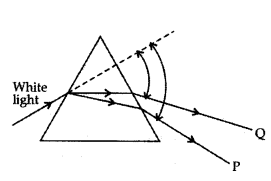
Answer:
The colours ‘P’ and ‘Q’ respectively are Violet and Red. p
Question 52.
Assertion (A) : Sky appears blue in the day time.
Reason (R) : White light is composed of seven colours.
a) Both A and R are true and R is the correct explanation of A.
b) Both A and R are true, and R is not the correct explanation of A
c) (A) is true, but R is false.
d) (A) is false but R is true.
Answer:
b) Both A and R are true, and R is not the correct explanation of A.
Question 53.
Mar’s atmosphere is composed mainly of carbon dioxide, nitrogen and argon and negligible amounts of oxygen, water vapour and methane.
Using the information given in the sentence above the knowledge about how rainbow are formed on Earth. Explain why rainbow formation is impossible on Mars.
Answer:
There is not enough water vapour in the atmosphere to cause scattering of light.
Question 54.
The apparent position of an object, when seen through the hot air, fluctuates or waves. State the basic cause of this observation.
Answer:
The basic cause of this observation is due to variation in physical condition of hot air.
Question 55.
Write the function of retina in human eye.
Answer:
Retina : It caputre light and convert it into electric signals that are translated into images by the brain.
The Human Eye and the Colourful World Class 10 Important Questions - 2 Marks
Question 1.
What is the nature of eye lens of human eye and that of the image formed at the retina of the eye by it ?
Answer:
The nature of eye lens in human eye is convex nature of the image formed on the retina by it is real, inverted and diminished.
Question 2.
Mention the role of optic nerve in the human eye.
Answer:
It transmits the visual information in the form of electrical signal generated at retina to the brain
Question 3.
Calculate maximum power of a person having normal vision.
Answer:
The least distance of distinct vision for normal eye is 25 cm. Therefore, maximum power of accommodation (P)
p = 100f( cm) = 10025 = 4 D
Question 4.
A person is able to see objects clearly only when these are lying at distances between 50 cm and 300 cm from his eyes. Name the kind of defects of vision he is suffering from.
Answer:
As person is suffering from both myopia and hypermetropia defect then this eye defect is presbyopia.
Question 5.
What is Tyndall effect ?
Answer:
The phenomenon of scattering of light by the particles of collodial solution is called Tyndall effect.
Question 6.
Give an example of a phenomenon where Tyndall effect can be observed.
Answer:
A fine beam of sunlight enters a room containing suspended particles of dust, the path of the beam of light is visible. It is due to the scattering of light (Tyndall effect).
Question 7.
The limitation of an eye is that the distance from the eye lens to where the image formed is always the same. How is then it possible for the eye to form focussed images from the objects that are located at varying distances form the eye ?
Answer:
The ability of eye lens to adjust its focal length with the help of ciliary muscles, it is possible for the eye to form focussed images from the eye. This mechanism is called accommodation.
Question 8.
Why does it take sometime to see the objects in dim light when you enter the room from bright sunlight outside ?
Answer:
In bright sunlight, the iris contracts the pupil to allow less light to enter the eye and in dim light, the iris expands the pupil to admit more light to see the object clearly. Therefore it takes sometime to increase the size of pupil in dim light.
Question 9.
Which part of the eye has delicate membrane and containing large number of light sensitive cells ?
Answer:
Retina contains large number of light sensitive cells known as rods and cones.
Question 10.
Name the defect of vision due to
i) Power of the eye is too long
ii) Focal length of the eye lens is too long
Answer:
i) Short - sightedness.
ii) Long - sightedness.
Question 11.
When a person said to have developed cataract ? How is the vision of such a person restored ?
Answer:
When the crystalline lens of eye becomes hazy (or even apaque) due to the formation of thin membrane over it, this causes partial or complete loss of vision. This defect of eye is called cataract. The vision of the defected eye can be restored by the cataract surgery.
Question 12.
Give reason ; The extent of deviation of a ray of light on passing through a glass prism depends on its colour.
Answer:
Refractive index of a medium is different for different colours of light.
Question 13.
What are the limits of accommodation power of a healthy human eye ?
Answer:
The limit of accommodation power of a healthy human eye between its farthest point (infinity) and a near point (25 cm).
Question 14.
State the function of retina of human eye.
Answer:
The retina of human eye contains millions of light-sensitive cells that work together to detect the light, turn it into electrical signals and communicate to the brain via optic nerves to produce vision.
Question 15.
You are given three lenses namely, bifocal lens, convex lens and concave leps. Which lens would you prefer to correct the myopia, hypermetriopia and presbyopia respectively ?
Answer:
| Eye defects |
Corrective lenses |
| Myopia |
Concave lens |
| Hypermetropia |
Convex lens |
| Presbyopia |
Bifocal lens |
Question 16.
A person needs a lens of power 4.5 D for correction of her vision.
i) What kind of defect in vision is the suffering from ?
ii) What is the focal length of the corrective lens ?
iii) What is the nature of the corrective lens ?
Answer:
i) Hypermetropia
ii) f = 1p = 14.5 = 0.22 m = 22 cm
P 4.5
iii) Convex lens
Question 17.
Name the defects of vision of human eye.
Answer:
i) Myopia, also called short sightedness or near sightedness
ii) Hypermetropia, also called long sightedness, far sightedness, or hyperopia.
Question 18.
Where is the image formed in an eye suffering from near sightedness ?
Answer:
The image is formed in front of retina.
Question 19.
What is long sightedness ?
Answer:
If a defect of the eye in which a person can see distant objects clearly, but cannot see near by objects clearly.
Question 20.
How does an eye manage to see objects in dim light and bright light ?
Answer:
An eye can manage to see objects in dim and bright light by the use of cones and rods.
Question 21.
When you enter from a bright sun shine into a dark room, you are not able to see clearly for sometime, why ?
Answer:
Because the size of the pupil had become small in bright light.
Question 22.
How can you identify regarding the type of defect a person is suffering from by physically touching his spectacles ?
Answer:
By touching the spectacles we can find out whether the lens is concave or convex and hence, the defect from which he suffers.
Question 23.
Give one example in nature where we can see dispersion of white light.
Answer:
The rainbow formed on a rainy day is an example of dispersion of light.
Question 24.
What happens to the lens and the ciliary muscles, when you are looking at nearby objects ?
Answer:
The ciliary muscles contract and the lens becomes thick i.e. it radius of curvature decreases.
Question 25.
Can an observer see a rainbow on the Moon ?
Answer:
No, since there is no atmosphere on the Moon.
Question 26.
Is the position of a star as seen by us in its true position ? Justify your answer.
Answer:
No, light from stars undergoes atmospheric which occurs in medium of gradually changing refractive index. So, we see the apparent position of the star after refraction by atmosphere.
Question 27.
Why sometimes haloes or rings are observed round the Moon or Sun ?
Answer:
When the Moon or the Sun is observed through a thin layer of the high douds, reflection of light from fine icy crystals, present in clouds, results in the formation of haloes.
Question 28.
Why are ‘danger’ signal lights red in colour ?
Answer:
Danger signal lights are red in colour because the red coloured light having longer wavelength is scattered the least by fog are smoke. Therefore, it can be seen clearly from a distance.
Question 29.
Observe the figure and answer the questions.
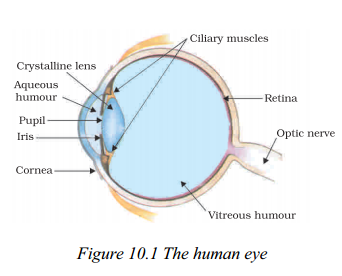
i) What is the structure shown in Figure ?
Answer:
The structure shown in Figure is the human eye.
ii) What is the function of the cornea in the human eye ?
Answer:
The cornea is a thin membrane through which light enters the eye.
ii) What is the purpose of the retina in the human eye ?
Answer:
The retina is a light-sensitive membrane that forms an inverted real image of objects on it. It contains light-sensitive cells that generate electrical signals, which are sent to the brain via the optic nerves for interpretation.
Question 30.
Observe the figures and answer the questions.
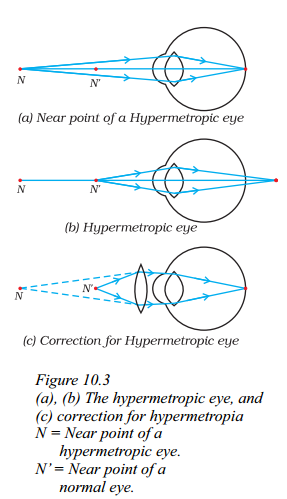
i) From Figure, what does N represent
a) Near point of a hypermetropic eye
b) Near point of a myopic eye
c) Near point of a normal eye
d) Near point of a presbyopic eye
Answer:
a) Near point of a hypermetropic eye
ii) What does N’ represent in Figure ?
a) Far point of a hypermetropic eye
b) Far point of a myopic eye
c) Far point of a normal eye
d) Far point of a presbyopic eye
Answer:
c) Near point of a normal eye
iii) According to Figure, how is hyperrnetropia corrected ?
a) Using a concave lens
b) Using a convex lens
c) Using a biconvex lens
d) Using a biconcave lens
Answer:
b) Using a convex lens
Question 31.
Observe the figure and answer the questions.
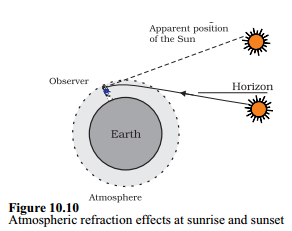
i) What does Figure illustrate ?
Answer:
Figure illustrates the atmospheric refraction effects at Sunrise and Sunset.
ii) What causes the apparent flattening of the Sun’s disc at sunrise and sunset ?
Answer:
The apparent flattening of the Sun’s disc at Sunrise and Sunset is caused by the phenomenon of atmospheric refraction.
iii) How does the time difference between actual Sunset and apparent Sunset compare?
Answer:
The time difference between actual Sunset and apparent Sunset is about 2 minutes
Question 32.
Read the paragraph and answer the questions.
"Persons who were infected with or died because of AIDS, Hepatitis B or C, rabies, acute leukemia, tetanus, cholera, meningitis or encephalitis cannot donate eyes. An eye bank collects, evaluates and distributes the donated eyes. All eyes donated are evaluated using strict medical standards. Those donated eyes found unsuitable for transplantation are used for valuable research and medical education. The identities of both the donor and the recipient remain confidential. One pair of eyes gives vision to up to FOUR CORNEAL BLIND PEOPLE. "
i) What medical conditions prevent individuals from donating their eyes ?
Answer:
Persons who were infected with or died because of AIDS, Hepatitis B or C, rabies, acute leukemia, tetanus, cholera, meningitis, or encephalitis cannot donate eyes.
ii) What happens to donated e> s that are not suitable for transplantation ?
Answer:
Donated eyes found unsuitable for transplantation are used for valuable research and medical education.
iii) How many corneal blind people can be provided with vision from one pair of donated eyes ?
Answer:
One pair of eyes can give vision to up to four corneal blind people.
Question 33.
Observe the following diagram showing an image formation in an eye :
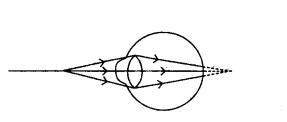
a) Identify the defect of vision shown in the figure.
b) List its two causes and suggest a suitable corrective lens to overcome this defect.
Answer:
a) Since the light rays from a nearby object are focused at a point behind the retina, the defect shown in the ray diagram is hypermetropia.
b) This defect arises either because the focal length of the eye lens is too long or the eyeball has become too small. To correct this defect of vision, a convex lens is used, which has the ability to converge incoming.rays for forming the image on the retina.
Question 34.
State the phenomena observed in the above diagram. Explain with reference to the diagram, which of the two lights mentioned above will have the higher wavelength?
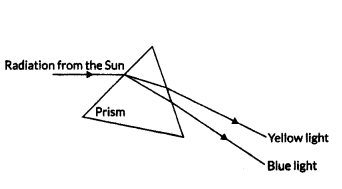
Answer:
- The phenomena observed in the above diagram is Dispersion.
- The splitting of white light into seven colours on passing through a prism.
- Velocity is directly proportional to wavelength given constant frequency.
- So yellow will have greater wavelength than blue as the velocity of yellow light is greater than blue.
Question 35.
Observe the following diagram and answer the questions following it.

i) Identify the defect of vision shown,
ii) List its two causes.
iii) Name the type of lens used for the correction of this defect.
Answer:
i) Myopia
ii) It’s two causes are :
- Enlongation of eyeball
- Eyelens become too convexed.
iii) We use concave lens to treat myopia.
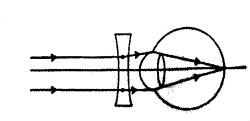
Question 36.
Write the function of each of the following parts of human eye :
i) Cornea
ii) Iris
iii) Crystalline lens
iv) Ciliary muscles
Answer:
i) Cornea - Refracts the rays of light falling on the eye.
ii) Iris - Controls the size of the pupil.
iii) Crystalline lens - Focuses the image of the object on the retina.
iv) Ciliary muscles - Holds the eye lens and adjusts its focal length.
Question 37.
Complete the path of white light when it passes through two identical prisms placed as shown :

Answer:
Complete diagram is -
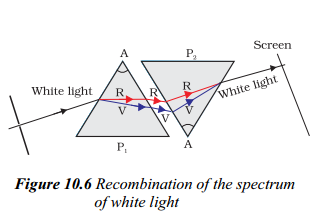
Question 38.
Akshay, sitting in the last row in his class, could not see clearly the words written oh the blackboard. When the teacher noticed it, he announced if any student sitting in the front row could volunteer to exchange his seat with Akshay. Salman immediately agreed to exchange his seat with Akshay. He could now see the words written on the blackboard clearly. The teacher thought it fit to send the message to Akshay’s parents advising them to get his eyesight checked.
In the context of the above event, answer the following questions.
a) Which defect of vision is Akshay suffering from ? Which type of lens is used to correct this defect ?
b) State the values displayed by the teacher and Salman.
c) In your opinion, in what way can Akshay express his gratitude towards the teacher and Salman ?
Answer:
a) Akshay is suffering from myopia or near sightedness. Concave lens is used for myopia.
b) Values displayed by teacher are scientific temperament, proactiveness, attentiveness. Values displayed by Salman are kindness, caring nature, helpful and value of friendship.
c) Akshay can express his gratitude by thanking them, helping them and studying well.
Question 39.
About 45 lac people in the developing countries are suffering from corneal blindness. About 30 lac children below the age of 12 years suffering from this defect can be cured by replacing the defective cornea with the cornea of a donated eye. How and why can students of your age involved themselves to create awareness about this fact among people.
Answer:
- Eyes of a dead person can be donated to the person having corneal blindness.
- It will help him/her see the world.
- We can also register ourselves to eye donation camps who can preserve our eyes after our death and donate them to the needy.
Question 40.
State the role of ciliary muscles present in our eye.
Answer:
- The main function of ciliary muscles present in our eye is changes the shape of lens in the eye to help with focusing.
- They also help in regulate the flow of aqueous humour in the eye.
Important Questions on The Human Eye and the Colourful World Class 10 - 4 Marks
Question 1.
Define following terms.
a) Pupil
b) Ciliary muscles
c) Iris
d) Retina
Answer:
a) Pupil : It controls and regulates the amount of light entering the eye.
b) Ciliary muscles : These muscles help to modify the curvature and there by the focal length of eye lens to focus the image of the object on the retina.
c) Iris : It controls the size of the pupil.
d) Retina : A real, inverted and diminished image of the object is formed on it.
Question 2.
In which of the following two cases the focal length of the eye lens will be more
a) When ciliary muscles of a normal eye is most relaxed.
b) When ciliary muscles of a normal eye is in most contracted state. Explain with > reason.
Answer:
The focal length of the eye lens will be more in case
a) i.e., when ciliary muscles of a normal eye is most relaxed.
b) Reason : When ciliary muscles are relaxed, the eye lens becomes thin. Thus, its focal length increases. In case when ciliary muscles is in most contracted state, radius of curvature of eye lens increases. Lens becomes thicker. This decreases the focal length of eye lens.
Question 3.
A student sitting at the back bench in a class, is not able to see what is written on the blackboard. He however, sees it clearly when sitting on the front seat at an approximate distance of 1.5 m from the black board. Draw ray diagrams to illustrate the image formation of the black board when he is seated at the i) back seat ii) front
Answer:
i) When student is seated at the back seat
Parallel rays from distant object (at infinity)

In this case student is suffering from myopia and have short focal length of eye lens,
ii) When student is seated at front seat.
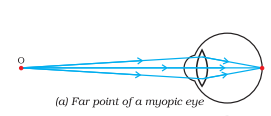
Question 4.
a) Which part the eye has delicate membrane and containing large number of light sensitive cells ?
b) A person is advised to wear spectacles with convex lenses. What type of defect of vision is he suffering from?
c) What happens to the size of pupil of our eye in i) dim light, ii) bright light ?
Answer:
a) Retina contains large number of light sensitive cells known as rods and cones.
b) Hypermetropia or far-sightedness. In this defect person is unable to see nearby objects clearly due to increase in focal length of eye lens.
c) i) increases,
ii) decreases.
Question 5.
Explain why ?
A myopic person prefer to remove his spectacles while reading a book.
Answer:
A myopic person does not need spectacles while reading a book as he has the near point at 25 cm. If such person reads the book with corrective lens (concave) he will have to keep the book the book at a distance greater than 25 cm, so that the image of book will be formed by the concave lens at 25 cm and moreover, the size of the book appears to him is also smaller then actual size. Therefore, the person prefer to remove his spectacles while reading a book.
Question 6.
The near point of a hypermetropic person is 75 cm from the eye. What is the power of the lens required to enable him to read clearly a book held at 25 cm from the eye?
Answer:
The near point of a hypermetropic person is 75 cm, so the focussing for objects closer than 75 cm is not possible. The person is far-sighted and can be corrected by convex lens of proper focal length. The near point for a perfect eye is 25 cm,
So u = -25cm, v = -75cm
Using lens formula, 1f=1v?1u we get,
1f = 1?75 + 125 ?1+375 = 275
∴ f = 752 = 37.5 cm
Power of lens, P = 1f( cm) = 20075 = 2.67 D
Question 7.
A person can see clearly objects only when the objects is lies between 40 cm and 350 cm. In order to Increase the distance of distinct vision to infinity, find the power of corrective lens and type of lens used by the person to see the objects clearly.
Answer:
Here, v = -350 cm = -3.5 cm ; u = -α, f = ?
Using lens formula 1f=1v?1u = 1?3.5 - 1?? = 13.5
⇒ f = - 3.5 m
Negative sign shows that corrective lens is concave lens and its power is
P = 1f( cm) = 13.5 = -0.28 D
Question 8.
In the given figure, a narrow beam of white light is shown to pass through a triangular glass prism. After passing through the prism it produces a spectrum XY on a screen.
i) State the colour seen at X and Y.
ii) Why do different colours of white light bend through different angles with respect to the incident beam of light ?
Answer:
i) X = Violent Y = Red
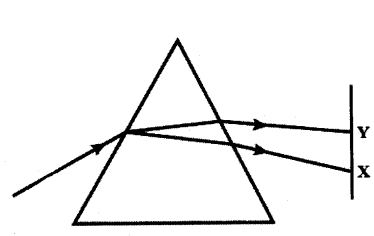
ii) Different, colours of white light bend through different angles with respect to the incident beam of light due to difference in speed of light of different wavelengths.
Question 9.
Explain giving reason why the sky appears blue to an observer from the surface of the Earth. What should the appearance of the sky be during the day for an astronaut staying in the international space station orbiting the Earth ? State reason to justify your answer.
Answer:
The fine particles in the atmosphere scatter light of shorter wavelength (blue colour) more strongly them the light of longer wavelength (red colour). Therefore, the sky appears blue from the surface of the Earth.
For an astronaut the sky would appear dark because in space there is no atmosphere to scatter light.
Question 10.
i) Draw a ray diagram to explain the term angle of deviation.
ii) Why do the component colours of incident white light split into a spectrum while passing through a glass prism, explain.
Answer:
i) 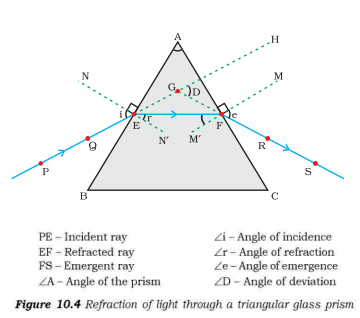
ii) Different colour of white light bend through different angles with respect to the incident light, as they pass through the glass prism. Thus each emerges along a different path, forming a spectrum.
Question 11.
A student uses spectacles of focal length - 2.5 m.
a) Name the defect of vision he is suffering from
b) Which lens is used for the correction of this defect ?
c) List two main causes of developing this defect.
d) Compute the power of this lens.
Answer:
a) Myopia.
b) Concave lens
c) i) The eye ball gets elongated along its axis,
ii) The focal length of the eye lens becomes short
d) P = 1f = 1?2.5m = -0.4 D
Question 12.
When we place a glass prism in the path of a narrow beam of white light a spectrum is obtained. What happens when a second identical prism is placed in an inverted position with respect to the first prism ? Draw a labelled diagram to illustrate it.
Answer:
Recombination of seven colours to form white light : As shown figure, take two identical prisms P1 and P2. Keep the second prism P2 upside down with respect to the first prism. Allow a narrow beam of white light to fall on first prism P1
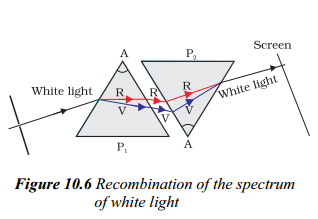
The first prism P1 disperses the white light into seven colours. The second prism P2 receives these seven colours and recombines them into white light. Thus a beam of white light emerges from the other side of the second prism. This observation gave Newton the idea that the sunlight is made of seven colours.
Any light that gives a spectrum similar to that of sunlight is called white light.
Question 13.
A beam of light consisting of red, blue and yellow colours is incident on prism, as shown in figure, (a) and (b). Complete the diagrams to show the refracted and emergent rays.
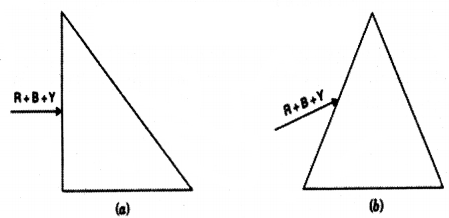
Answer:
In Fig. (a), the ray AB is incident normally, so it does not disperse in the prism but the emergent beam gets dispersed. In Fig. (b), dispersion occurs both inside and outside the prism.

Question 14.
What is the focal length of a lens required for correcting distant vision ?
Answer:
- The focal length of a lens required for correcting distant vision depends on the power of the lens.
- The power of the lens for correcting distant vision can be calculated using the formula P = 1/f, where P is the power of the lens and f is the focal length of the lens.
- To calculate the focal length of the lens required, we need to know the power of the lens for correcting distant vision.
- For example, if a person needs a lens of power - 5.5 dioptres for correcting distant vision, the focal length of the lens required can be-calculated by converting dioptres to metres (focal length = 1/power).
- So, the focal length of the lens required fqr correcting distant vision can be calculated
as 1/(- 5.5) = - 0.182 m or - 18.2 cm.
Question 15.
At what point does the human eye form an image of an object ?
Answer:
- The human eye forms an image of an object on the retina.
- The retina is a light-sensitive screen at the back of the eye.
- The image formed on the retina is inverted and real.
- The retina contains light-sensitive cells that generate electrical signals in response to light.
- These signals are then sent to the brain via the optic nerves.
- The brain interprets these signals, allowing us to perceive objects in their correct orientation and form.
Question 16.
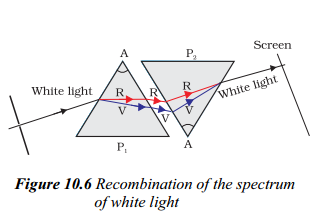
How is the spectrum of white light recombined in Figure ?
Answer:
- In Figure, the spectrum of white light is recombined by using a second prism.
- The second prism is placed in an inverted position with respect to the first prism.
- All the colours of the spectrum pass through the second prism.
- A beam of white light emerges from the other side of the second prism.
- This observation led Isaac Newton to conclude that sunlight is made up of seven colours.
Question 17.
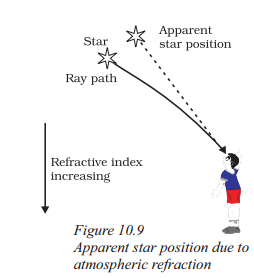
What is Figure about ?
Answer:
- Figure depicts the apparent position of a star due to atmospheric refraction.
- Atmospheric Refraction refers to the bending of light as it passes through the Earth’s atmosphere.
- The flickering or fluctuation of the star’s position in the image is caused by the turbulent streams of hot air rising above a fire or a radiator.
- This phenomenon is similar to the twinkling of stars, but on a smaller scale.
- The figure helps to explain how atmospheric refraction affects the apparent position of objects in our local environment.
Question 18.
Read the paragraph and answer the questions.
The human eye is one of the most valuable and sensitive sense organs. It enables us to see the wonderful world and the colours around us. On closing the eyes, we can identify objects to some extent by their smell, taste, sound they make or by touch. It is, however, impossible to identify colours while closing the eyes. Thus, of all the sense organs, the human eye is the most significant one as it enables us to see the beautiful, colourful world around us.
i) What makes the human eye the most significant sense organ ?
Answer:
The human eye is the most significant sense organ because it enables us to see the beautiful, colourful world around us.
ii) Why is it impossible to identify colours with your eyes closed ?
Answer:
It is impossible to identify colours with your eyes closed because the human eye is the only sense organ that enables us to see colours.
iii) How does the human eye enable us to see the world around us ?
Answer:
The human eye enables us to see the world around us by using light and forming an image on the retina. The retina is a delicate membrane having enormous number of light-sensitive cells.
iv) Compare and contrast the function of the human eye with other sense organs such as the nose or the ears.
Answer:
The human eye enables us to see objects, colours, and the world around us while the nose and ears enable us to smell and hear respectively.
Question 19.
Read the paragraph and answer the questions.
The eyeball is approximately spherical in shape with a diameter of about 2.3 cm. Most of the refraction for the light rays entering the eye occurs at the outer surface of the cornea. The crystalline lens merely provides the finer adjustment of focal length required to focus objects at different distances on the retina. We find a structure called iris behind the cornea. Iris is a dark muscular diaphragm that controls the size of the pupil.
i) What is the function of the crystalline lens in the human eye ?
Answer:
The function of the crystalline lens in the human eye is to provide the finer adjustment of focal length required to focus objects at different distances on the retina.
ii) How does the iris control the amount of light entering the eye ?
Answer:
The iris controls the amount of light entering the eye by changing the size of the pupil.
iii) What is the structure of the human eyeball ?
Answer:
The human eyeball is approximately spherical in shape with a diameter of about 2.3 cm. It has a cornea, a crystalline lens, an iris, and a retina.
iv) Explain how the cornea and the crystalline lens work together to focus light on the retina.
Answer:
The cornea is responsible for most of the refraction for the light rays entering the eye, while the crystalline lens provides the finer adjustment of focal length required to focus objects at different distances on the retina. Together, they work to focus light on the retina.
Question 20.
a) A person is suffering from both myopia and hypermetropia.
i) What kind of lenses can correct this defect ?
ii) How are these lenses prepared ?
b) A person needs a lens of power + 3D for correcting his near vision and - 3D for correction his distant vision. Calculate the focal lengths of the lenses required to correct these defects.
Answer:
a) i) Biofocal lenses are used to correct the defect when a person suffers from both the defects of vision myopia and hypermetropia.
ii) Bifocal lens is made by using two lenses in one eyepiece. Convex lens of appropriate focal length is positioned below while concave lens of appropriate focal length is positioned above.
b) We know that, Power of lens (P) = 1f or f = 1P
So, focal length (f) of lens for near vision = 13 = +0.33 m
And focal length of lens for distant vision = - 13 = -0.33 m
Question 21.
The colour of clear sky from the earth appears blue but from the space it appears
black. Why ?
Answer:
- The colour of the clear sky appears blue from the Earth due to a phenomenon called Rayleigh scattering.
- The Earth’s atmosphere contains various gases and particles, including nitrogen and oxygen molecules.
- When sunlight passes through the atmosphere, these molecules scatter the sunlight in all directions, causing the blue light to be scattered more than other colours, giving thfe sky its blue colour.
- However, from space, the atmosphere is not visible, so the sky appears black because there is no medium for the scattering of sunlight.
- The light from the sun is not scattered, and there is no atmospheric interference, which makes the sky appear black.
Question 22.
Differentiate between a glass slab and a glass prism.
| Glass Slab |
Glass Prism |
| i) Glass slab is a transparent plate in which both reflecting surface are parallel to each other. |
i) Prism is a transparent plate in which both reflecting surface are at an angle. |
| ii) In glass slab, the direction of incident ray and the emergent ray of light are parallel to each other. |
ii) In glass prism, the direction of the incident ray and the emergent ray of light is not parallel to each other. |
Question 23.
What is a rainbow? Draw a labelled diagram to show the formation of a rainbow.
Answer:
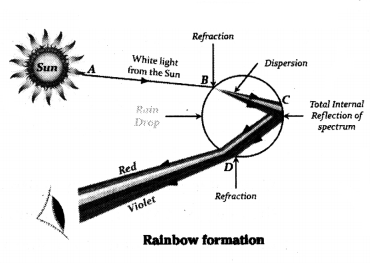
- A rainbow is a natural spectrum of sunlight in the form of bows appearing in the sky when the sun shines on rain drops.
- It is formed by dispersion of sunlight by tiny droplets presents in the atmosphere.
- Water droplets act as small prisms.
- They refract and disperse the sunlight, then reflect it internally and finally refract it again when it comes out of the raindrop.
Question 24.
A narrow PQ of white light is passing through a glass prism ABC as shown in the diagram.
Trace it on your answer sheet and show the path of the emergent beam as observed on the screen DE.
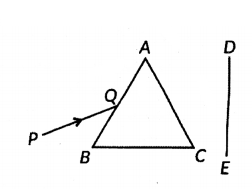
i) Write the name and cause of the phenomenon observed.
ii) Where else in nature is this phenomenon observed ?
iii) Based on this observation, state the conclusion which can be drawn about the constituents of white light.
Answer:
i) The phenomenon of the splitting up of the white light into its constituent colours is called dispersion of light. Dispersion of light is caused because different constituent colours of light offer different refractive indexes to the material of the prism.
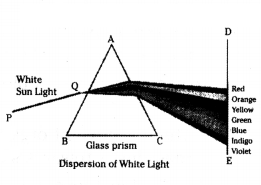
ii) The formation of the rainbow is caused by the dispersion of the white sunlight into its constituent colours.
iii) Based on the dispersion of white light into its constituent colours, we can conclude that :
a) the white light consists of seven colours.
b) the violet light suffers maximum deviation and the red light suffers minimum deviation.
Question 25.
Identify the defect of vision in each of the following cases and suggest its corrective measure :
i) The eye lens has become milky and cloudy.
ii) The eye lens has excessive curvature.
iii) The eye lens has large focal length (longer than normal).
iv) Ciliary muscles have weakened.
Answer:
i) Contract : it can be corrected by Surgery.
ii) Myopia : it can be corrected by using a concave lens.
iii) Hypermetropia : it can be corrected by using a convex lens.
iv) Presbyopia : it can be corrected by bifocal lens
Question 26.
Millions of people of the developing countries of world are suffering from corneal blindness. These persons can be cured by replacing the defective cornea with the cornea of a donated eye. A charitable society of your city has organised a campaign in your neighbourhood in order to create awareness about this fact. If you are asked to participate in this mission how would you contribute in this noble cause ?
a) Stale the objective of organising such campaigns.
b) List two arguments which you would give to motivate the people to donate their eyes after death,
c) List two values which are developed in the persons who actively participate and contribute in such programmes.
(OR)
Millions of people of the developing countries are suffering from corneal blindness. This disease can be cured by replacing the defective cornea with the cornea of a donated eye. Your school has organised a campaign in the school and its neighbourhood in order to create awareness about this fact and motivate people to donate their eyes after death. How can you along with your classmates contribute in this noble cause ? State the objectives of organising such campaigns in schools.
Answer:
We can encourage people to participate in the camp and also register ourselves as a donator.
a) The objective of organising such campaign is to make people aware and realise their duties towards society.
b) i) By donating our eyes after we die, we can light the life of a blind person,
ii) One pair of eyes gives vision to two corneal blind people.
c) i) It shows the concern for others.
ii) It also shows the responsible behaviour towards the society.
Extra Questions on The Human Eye and the Colourful World Class 10 - 8 Marks
Question 1.
What is myopia ? State the formation of image of a distant object by a myopic eye. How can such an eye defect be remedied ?
Answer:
a) Myopia or short-sightedness: It is a vision defect in which a person can see nearby objects clearly but cannot see the distant objects clearly beyond a certain point. This defect is common among children.
Cause of Myopia :
i) The eye ball gets elongated along its axis so that the distance between the eye lens and the retina becomes larger.
ii) The focal length of the eye lens becomes too short due to the excessive curvature of cornea.
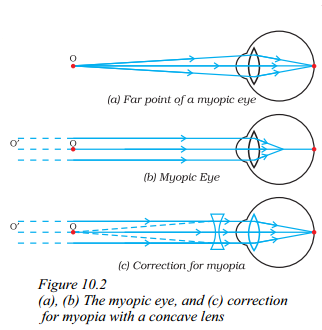
As a result qf the above causes, the parallel rays coming from a distant object do not meet at the retina but at a point in front of the retina, as shown in fig. (b) and the distant object is not seen clearly. The object has to be moved closer to the eye to a point F to focus it on the retina, as shown in fig.(a). Thus, the far point of a myopic eye is not at infinity but only a few metres from the eye.
Correction of Myopia : A myopic eye is corrected by using a concave lens of focal length equal to the distance of the far point F from the eye. This lens diverges the parallel rays from distant object as if they are coming from the far point F. Finally, the eye lens forms a clear image at the retina.
Question 2.
Draw a diagram to illustrate hypermetropia or far-sightedness. How is it corrected by using spectacles filled with convex lenses ? Draw a diagram to explain it.
Answer:
a) Hypermetropia or long-sightedness: It is a vision defected in which a person can see the distant objects clearly but cannot see the nearby objects clearly.
b) Cause of Hypermetropia :
i) The eye ball becomes too small along its axis so that the distance between the eye lens and the retina is reduced.
ii) The focal length of the eye lens becomes too large resulting in the low converging power of the eye lens.
As a result of the above causes, the rays coming from an object placed 25 cm (normal near point) from the eye meet at a point behind the retina, as shown in fig. (b) so the object is not seen clearly.
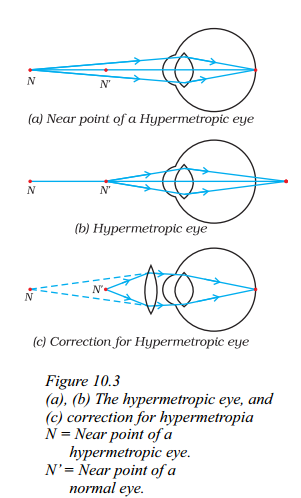
To focus the rays again on the retina, the object has to be moved away from the eyes to a distance greater than 25 cm, as shown in fig (a). Thus, the near point of the eye is not at 25 cm but it has shifted to N’ at a distance greater than 25 cm from the eyes.
Correction of hypermetropia : A hypermetropic eye is corrected by using a convex lens of suitable focal length. Thus lens diverges the rays such that the rays coming from normal near point N appear to come after refraction, from near point N’ of the defected eye. That is, a virtual image of the object placed at N is formed at N’. Then the eye lens forms a clear image at the retina as shown fig (c).
Question 3.
a) A person can see objects if they are placed at 1.5 m. What kind of lens would be required to read a book at a distance of 25 cm ? What kind eye defect is it ? Calculate the power of lens used to correct the defect.
b) The limitation of an eye is that the distance from the eye lens to where the image formed is always the same. How is then it possible for the eye to form focussed images from the objects that are located at varying distances from the eye ?
Answer:
a) According to question, the nearest image seen by the person is 150 cm away from him but he want to see on object placed 25 cm away. To do this, virtual image need to be formed at 150 cm.
Accordingly, eye defect is hypermetropia.
But putting u = -25 cm, v = -150 cm
In the lens formula 1f=1v?1u we get,
1f = 1?150 - 1?25 = - 1150 - 1?25 = ?1+6150 = +5150 = +130
⇒ f = +30 cm
Now, Power P = 1f( cm) = 100f( cm) = +10030 = +3.3 D
b) The ablity of eye lens to adjust its focal length with the help of ciliary muscles, it is possible for the eye to form focussed images from the objects that are located at varying distances from the eye. This mechanism is called accommodation.
Question 4.
a) A very thin narrow beam of white light is made incident on three glass objects as shown below. Comment on the nature of behaviour of the emergent beam in all three cases.

b) There is a similarity between two of the emergent beams. Identify the two.
Answer:
a) i) The emergent beam, refracted through a rectangular glass slab, emerges parallel to the incident rays and is shifted side ward slightly Therefore, no dispersion occurs.
ii) A prism splits the incident thin narrow beam of white light into a band of seven colours which are violet, indigo, blue, green, yellow, orange and red. These coloured rays emerge out through the prism along different direction and becomes distinct, hence the incident white light beam gets dispersed.
iii) The emergent beam from the second identical inverted prism is again a beam of white light and emerges parallel to the incident beam and shifted sideward slightly.
b) The similarity between the emergent beam in cases (i) and (iii) is the same as in both the cases, the emergent beams is emerges from the opposite parallel faces and parallel to the incident ray.
Question 5.
What is a rainbow ? Draw a labelled diagram to show the formation of a rainbow.
Answer:
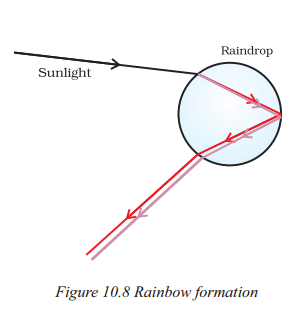
- A rainbow is a natural specturm appearing in the sky after a rain.
- It produced by dispersion of sunlight by tiny water droplets, present in the atmosphere.
- The water droplets act like small prisms.
- When a ray of light falls on water drop or rain drop it undergoes refraction and dispersion to form a spectrum.
- This spectrum undergoes internal reflection (in side the raihdrop) and finally refracted again when it comesout of the raindrop.
- After the dispersion of light and internal reflections, the band of colours reaches observer’s eye in the form of a rainbow.
- A rainbow is always formed in the direction opposite to that of the sun.
Question 6.
What is atmospheric refraction ? Use this phenomenon to explain advance sunrise and delayed sunset ? Draw diagram to illustrate your answers.
Answer:
Atmospheric Refraction : The refraction of light caused by the earth’s atmosphere due to gradual change in the refractive indices of its different layers by the varying conditions of it, is called atmospheric refraction.

Advance Sunrise and Delayed Sunset :
- The sun is visible to us about 2 minutes before the actual sunrise, and about 2 minutes after the actual sunset because of atmospheric refraction.
- By actual sunrise, we mean the actual crossing of the horizon by the sun.
- Figure shows the actual and apparent positions of the sun with respect to the horizon.
- The time difference between actual sunset and the apparent sunset is about 2 minutes.
- The apparent flattening of the sun’s disc at Sunrise and Sunset is also due to the same phenomenon.
Question 7.
Explain the structure of the human eye and how it enables us to see.
Answer:
The structure of the human eye and how it enables us to see can be explained as follows :
- The human eye is like a camera, with a lens system that forms an image on the retina.
- Light enters the eye through the cornea, a transparent bulge on the front surface of the eyeball.
- The cornea and the lens work together to focus the light onto the retina, a delicate membrane at the back of the eye.
- The retina contains light-sensitive cells that get activated upon illumination and generate electrical signals.
- These signals are sent to the brain via the optic nerves, and the brain interprets them to create the perception of objects.
- The eye also has the ability to adjust its focal length, called accommodation, which helps in focusing on objects at different distances.
- Common refractive defects of vision, such as myopia (short-sightedness) and hypermetropia (far-sightedness), can be corrected using suitable lenses.
- The human eye also enables us to see the colourful world around us by allowing the entry of different wavelengths of light that stimulate the colour-sensitive cells in the retina.
- The eye works in conjunction with the brain to process the information and create the perception of colours.
- Overall, the structure and functioning of the human eye enable us to perceive the visual world with clarity and distinguish different colours and objects.
Question 8.
Illustrate the correction of hypermetropia using a diagram and explain its underlying
principle.
Answer:
Hypermetropia, also known as far-sightedness, is a refractive defect of vision where the image of nearby objects is focused beyond the retina. The correction of hypermetropia involves the use of a convex lens.
Here is a simple explanation of the correction process :
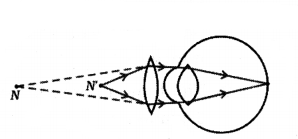
- Hypermetropia occurs when the focal length of the eye lens is too long or when the eyeball is too small.
- The light rays from a close object entering the hypermetropic eye converge behind the retina.
- To correct hypermetropia, a convex lens is used.
- The convex lens converges the incoming light N rays before they reach the eye lens.
- By using a convex lens, the eye lens now converges the light rays correctly on the retina.
- The corrected image is formed on the retina, allowing clear vision of nearby objects.
- The power of the convex lens required for correcting hypermetropia is determined based on the refractive power needed to bring the image onto the retina.
- It is important to use the correct power of lens prescribed by an optometrist for effective correction of hypermetropia.
- Diagram illustrating the correction of hypermetropia.
Question 9.
Explain the concept of dispersion of white light by a glass prism and how it forms a
spectrum.
Answer:
- Dispersion of white light by a glass prism causes the formation of a spectrum.
- White light from a source, such as sunlight, is allowed to fall on a glass prism.
- When the light enters the prism, it bends or refracts due to the different refractive indices of the glass for different colours of light.
- Each colour of light bends at a different angle, with red light bending the least and violet light bending the most.
- As a result, the white light gets split into its component colours - red, orange, yellow, green, blue, indigo, and violet.
- These colours form a band of distinct colours, which is known as a spectrum.
- The sequence of colours in the spectrum is Violet, Indigo, Blue, Green, Yellow, Orange, and Red (VIBGYOR).
- The spectrum can be observed when the light that comes out of the prism falls on a screen or surface.
- This phenomenon was first observed by Sir Isaac Newton using two identical prisms. He found that white light is made up of these seven colours.
- The dispersion of white light by a prism is due to the different angles of refraction for different colours of light.
- This dispersion of white light is also the reason behind natural phenomena such as rainbows, where water droplets in the air act as tiny prisms and split sunlight into its component colour.
Question 10.
Analyze the phenomenon of atmospheric refraction and its impact on the visibility of the Sun.
Answer:
- Atmospheric refraction causes the Sun to be visible to us about 2 minutes before the actual sunrise and 2 minutes after the actual sunset.
- The apparent flattening of the Sun’s disc at sunrise and sunset is also due to atmospheric refraction.
- Atmospheric refraction is caused by the Earth’s atmosphere bending light as it passes through it.
- The interplay of light with fine particles in the atmosphere leads to the scattering of light, which can affect visibility.
- The molecules of air and other fine particles in the atmosphere scatter blue light more strongly than red light, resulting in the blue colour of the sky.
- The scattering of light by fog or smoke is least for red light, which is why "danger" signal lights are often red.
- The phenomenon of atmospheric refraction can cause flickering of objects seen through a turbulent stream of hot air, and it is similar to the twinkling of stars.
- Atmospheric refraction has an impact on the apparent position of the Sun with respect to the horizon, causing a time difference between actual sunset and apparent sunset.
- The phenomenon of atmospheric refraction affects our visibility of the Sun during sunrise and sunset, creating the stunning colours and beauty of the sky that we often observe.
- Atmospheric refraction is a natural phenomenon that plays a significant role in our perception of the Sun’s position and the colours we see in the sky.
Question 11.
Elaborate on the factors that contribute to the splitting of white light into its component colours through a prism.
Answer:
Factors contributing to the splitting of white light into its component colours thrbugh a prism include :
1) Refraction : White light consists of different colours with varying wavelengths. When white light enters a prism, it undergoes refraction at each surface of the prism, causing the different colours to bend at different angles.
2) Dispersion : As the different colours of light bend at different angles, they spread out or disperse within the prism, creating a spectrum of colours.
3) Refractive index: Each colour of light has a different refractive index, which is the measure of how much the light bends when passing through a medium. The refractive index of a material, such as glass, causes the different colours to refract at different angles, leading to the separation of the colours within the prism.
4) Angle of deviation : The shape of the prism produces an angle of deviation, which refers to the angle at which the emergent ray of light bends away from the incident ray. The angle of deviation contributes to the dispersion of white light into a spectrum of colours.
5) Angle between prism surfaces: The angle between the two lateral surfaces of the prism determines the degree of bending and separation of the colours. A larger angle of the prism will result in a greater dispersion of the colours.
6) Multiple reflections : As light passes through the prism, it undergoes multiple reflections inside the prism due to the geometry of the shape. These multiple reflections further contribute to the splitting of white light into its component colours.
7) Newton’s experiments: Sir Isaac Newton’s experiments with prisms helped to understand the splitting of white light. He found that a single prism could split white light into a spectrum of colours, and an additional prism in an inverted position could recombine the colours, proving that white light is made up of different colours.
8) Different wavelengths of light: Each colour of light corresponds to a specific wavelength. As the different colours of light pass through the prism, their wavelengths determine how much they are refracted and separated, resulting in the distinct spectrum of colours.

Question 12.
Explain the concept of the angle of deviation in the refraction of light through a triangular glass prism and its measurement.
Answer:
- The angle of deviation refers to the angle at which the emergent ray bends or deviates from its original path after passing through a triangular glass prism.
- It can be measured by comparing the angle of incidence, angle of refraction, and angle of emergence in a refraction experiment using a prism.
To measure the angle of deviation, one can perform the following steps :
- Take a thick sheet of cardboard and make a small hole or narrow slit in its middle.
- Draw a straight line inclined to one of the refracting surfaces of the prism.
- Fix two pins on the line as reference points.
- Look for the images of the pins through the other face of the prism.
- Fix two more pins such that the pins and their images lie on the same straight line.
- Remove the pins and the prism.
- Join the points where the line intersects the prism boundary with the points where the pins and their images intersect the boundary.
- Draw perpendiculars to the refracting surfaces of the prism at the points of inter-section.
- Measure the angle between the incident ray and the refracted ray, which repre¬sents the angle of deviation.
- By following these steps, one can determine the angle of deviation in the refraction of light through a triangular glass prism and measure it accurately.
Question 13.
Explain the concept of power of accommodation of the eye and its significance in focusing on near and distant objects.
Answer:
- The power of accommodation refers to the ability of the eye to adjust its focal length in order to focus on objects at different distances.
- The eye can focus on both near and distant objects by changing the curvature of the lens. The minimum distance at which the eye can see objects clearly without strain is called the near point of the eye or the least distance of distinct vision.
- For a young adult with normal vision, the near point is about 25 cm.
- The power of accommodation allows the eye to bring objects into focus within this range.
- When focusing on near objects, the ciliary muscles in the eye contract, causing the lens to become more rounded and increase its refractive power.
- When focusing on distant objects, the ciliary muscles relax, causing the lens to flatten and decrease its refractive power.
- This adjustment of the lens allows the image of the object to be formed precisely on the retina, resulting in clear vision.
- The power of accommodation decreases with age, leading to difficulties in focusing on nearby objects, a condition known as presbyopia.
- Corrective lenses, such as glasses or contact lenses, can be used to compensate for refractive defects and restore proper focusing ability.
Question 14.
Describe the phenomenon of dispersion of white light and the formation of a
spectrum using a glass prism.
Answer:
- The phenomenon of dispersion occurs when white light passes through a prism and splits into its component colours.
- This happens because different colours of light bend through different angles as they pass through the prism.
- The red light bends the least and the violet light bends the most. As a result, the colours of the spectrum, including violet, indigo, blue, green, yellow, orange, and red, become distinct.
- This sequence of colours can be observed as a band of colours when the light passes through the prism.
- The process of dispersion demonstrates that white light is actually made up of different colours. Isaac Newton was the first to discover this by using a glass prism to split sunlight into its component colours.
- He observed that when the spectrum of colours obtained from the first prism was passed through another prism, all the colours of the spectrum recombined to form white light again.
- The dispersion of white light and the formation of a spectrum using a glass prism can also be seen in a natural phenomenon called a rainbow.
- A rainbow is caused by the dispersion of sunlight by tiny water droplets in the atmosphere.
- The water droplets act like small prisms, scattering and refracting the Sunlight to form a band of colours.
- The colours of the rainbow are always formed in a direction opposite to that of the Sun.
Question 15.
State the cause of dispersion of white light by a glass prism. How did Newton, using two identical glass prisms, show that white light is made of seven colours ? Draw a ray diagram to show the path of a narrow beam of white light, thought a combination of two identical prisms arranged together in inverted position with respect to each other, when it is allowed to fall obliquely on one of the face of the first prism of the combination.
Answer:
A)
- Light is formed of different colours which travel at their own speed inside a prism.
- Due to which the light bends the through different angles with respect to the incident ray, as they pass through a prism.
- The red light bends the least while the violet most causing dispersion this can be explained by the fact that light of different colours having different wavelengths has different velocities while travelling in a medium vm = nlm.
B)
- Newton showed that the reverse of dispersion of light is also possible.
- If we kept two prisms close to each other one in erect position and the other in an inverted position, the light get dispersed when passes through the first prism.
- The second prism receives all the seven coloured rays from first prism and combines into original while light i.e., recombine the different colours of spectrum and hence gives white light.
- This proves that white light is made of seven constituents colours (VIBGYOR).
C) Ray Diagram :

Question 16.
a) A student suffering from myopia is not able to see distinctly the objects placed beyond 5 m. List two possible reasons due to which this defect of vision may have arisen. With the help of rays diagrams, explain.
i) why the student is unable to see distinctly the objects placed beyond 5 m from his eyes.
ii) the type of the corrective lens used to restore proper vision and how this defect is corrected by the use of this lens.
b) If, in this case, the numerical value of the focal length of the corrective lens is 5m, find the power of the lens as per the new Cartesian sign convention.
Answer:
a) The student is unable to see distinctly the objects placed beyond 5 m from his eyes as he is suffering from myopia i.e., near-siightedness where a person can see near by objects clearly but cannot see distant objects distinctly,
i) This defect arises due to
- reduced radii of curvature of lens
- increases in distance between eye lens and retina.
i) The student is uable to see distinctly the objects placed beyond 5 m from his eyes because the image of distant object is formed before retina instead of retina.
ii) Concave lens can be used to diverge the light rays before they enter the eye as the corrective lens to restore proper vision. A concave lens of suitable focal length will bring the image back on the retina and thus the defect is corrected.
b) Given, u = - ? and v = -5 m
Using lens formula, 1f = 1v - 1u
⇒ 1f = 1?5 - 1??
⇒ 1f = 1?5 - 0 ⇒ f = -5m
Power of the lens, P = 1f = 1(?5) = - 0.2 D
Question 17.
Do you know that the corneal-impairment can be cured by replacing the defective cornea with the cornea of the donated eye? How and why should we organise groups to motivate the community members to donate their eyes after death ?
Answer:
- Yes, we know that the corneal - impairment can be cured by replacing the objective cornea with the cornea of the donated eye.
- We can provide the importance of eye donation to the community members.
- Our eyes can live even after our death.
- By donating our eyes after die, we can light the life of a blind person.
- The human eye is one of the most valuable and sensitive sense organs.
- 6) It enables us to see the wonderful world and colours around us.
- It is however, impossible to identify colours while closing the eyes.
- Thus of all the sense organs, the human eye is the most significant one as it enables as to see the beautiful colourful word around us.
- Hence, we should donate our eyes after death.